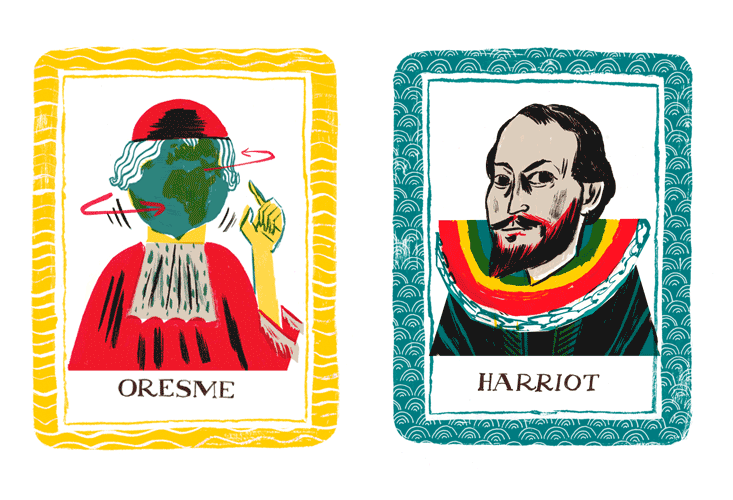It’s easy to name science and math geniuses. I can just flip open my old book from the 1960s, which lists “100 Great Scientists”; it contains all the names you’d find on most popular lists of scientific geniuses: Einstein, Newton, Maxwell, Gauss, Bohr, Archimedes, Darwin, Galileo, and 92 others.
But the geniuses of popular notoriety aren’t the only great minds of scientific history. That book and other such lists overlook many deserving names—the unsung geniuses overshadowed by more publicity-savvy rivals or under-appreciated because of when and where they lived. Presented below are my Top 10 of those insufficiently recognized scientific geniuses of all time, listed in chronological order.
Keep in mind that this is science and math only, so no Shakespeare, no Bobby Fischer, no Lennon and McCartney. Also, nobody still living is eligible—wouldn’t want to hurt anybody’s feelings.
And remember, for list-making purposes, genius shouldn’t simply be thought of as high IQ. It’s more a combination of intellectual capacity and what was achieved with it. Geniuses transcend the time in which they live, contributing insights that allow future scientists to be smarter than the geniuses of the past. All the people listed here did that. If there’s someone you think should have made the cut, by all means, let Nautilus know in the comments below.

10. Brahmagupta (India, 598-c.670)
A prominent astronomer, Brahmagupta wrote an extensive treatise covering such topics as the motions of the planets, eclipses, and the phases of the moon. But his genius emerged most prominently in mathematics. He introduced the idea of zero as a number like any other and discussed how to calculate with it. He was also the first to explain negative numbers, a concept thought by the Greeks to be “absurd.” Brahmagupta pointed out that multiplying two negative numbers (he called them “debts”) produced a positive number (in his terminology, a “fortune”).
9. Robert Grosseteste (England, c. 1170-1253)
Grosseteste was a prominent churchman who served as the Bishop of Lincoln for the last 18 years of his life. But in his earlier days he was a master of all the sciences, from medicine to cosmology. In fact, he was among the first modern scientific thinkers of the Middle Ages. He respected Aristotle but taught that experiment took precedence over authority. Grosseteste was an expert in optics, considering light to be the fundamental substance of existence; its power gave the cosmos shape, pushing matter around to form the heavenly spheres. Roger Bacon, the more widely known scientific pioneer of the 13th century, held Grosseteste in the highest esteem, while dismissing most other big scientific names of the day as dimwits.

8. Nicole Oresme (France, c. 1320-1382)
One of the most sophisticated mathematicians of his era, Oresme worked out the logical demonstration that all observable evidence was consistent with the Earth’s rotating on its axis, rather than the sun actually rising and setting. His true genius, however, was in then stating that he didn’t really believe that the Earth rotated, so that he could keep in good standing with the church (he was a bishop) and not get put under house arrest or burned at the stake.
7. Thomas Harriot (England, c. 1560-1621)
Harriot was a master of many sciences, starting with his role as scientist for an expedition to Roanoke Island in 1585. Later in his life he became the preeminent mathematician in England, a pioneer in the establishment of algebra for both pure and applied math. As an astronomer, he observed features on the moon and spotted the moons of Jupiter, possibly even before Galileo. His works on optics included an analysis of the physics of rainbows. Most of his writings went unpublished in his lifetime; hence many later mathematicians rediscovered much that Harriot had already accomplished or foreseen.

6. Antoine Parent (France, 1666-1716)
Parent applied his versatile intellect to a vast scope of scientific fields. He investigated physics and astronomy, cartography and geometry, chemistry and biology, and even music. He was most astute in analyzing practical matters such as friction’s effect on motion and stresses on structural beams, and attempted to compute the theoretical maximum efficiency of machines. For his exemplar he chose water wheels, widely used to harness the power of flowing streams for such tasks as sawing wood or milling grain. Parent got the wrong answer, but nevertheless laid the groundwork for the second law of thermodynamics. Parent’s harsh criticism of Descartes’ science earned him no friends among his French colleagues, though, who considered Parent to be tactless and aggressive. After he died of smallpox, one obituary writer commented that Parent “had goodness without showing it.”
5. Mary Somerville (Scotland, 1780-1872)
She was the Carl Sagan of the 19th century, one of the most respected and prolific popularizers of science of her age. Her one year of formal schooling (at age 10) triggered enough curiosity that she taught herself algebra and geometry (mostly in secret, as her father disapproved). She married and moved to London, but her husband died young, so she returned to Scotland and to science. When asked to translate Laplace’s works on celestial mechanics into English, she turned the translation into a popular explanation, launching a career of writing books that conveyed the cutting edge of 19th-century science to the wider literate public. Her work, universally praised by the scientific community, combined the genius of insight with the ability to convey it.

4. Adolphe Quetelet (Belgium, 1796-1874)
As a youth, Quetelet dabbled in writing operas and poetry, but wisely switched to math, before becoming an astronomer and ultimately the most accomplished statistician of his day. Quetelet especially perceived the importance of statistical reasoning for the social sciences. He demonstrated how the prevalence of various crimes could be predicted, for instance. He also recognized the fallacies that improper statistical reasoning could propagate, noting that the numbers said nothing about any individual, but that nonetheless the statistical construction of an “average man” could reveal much about society as a whole. Also, to the benefit (or annoyance) of many dieters, he developed the formula for Body Mass Index, so that you can properly quantify how overweight you are.
3. William Kingdon Clifford (England, 1845-1879)
A brilliant mathematician, Clifford was in ill health for most of his adult life and died at 33. Even so he earned international repute for his original approaches to geometry and other aspects of mathematics. His work foreshadowed aspects of Einstein’s general theory of relativity; Clifford pointed out that “some or all of those causes which we term physical may… be due to the geometrical construction of our space,” anticipating Einstein’s description of gravity as curvature in the geometry of spacetime, the combination of space and time implied by his special theory of relativity.

2. Emile Borel (France, 1871-1956)
By age 11, Borel’s genius was apparent enough that he left home to receive more advanced instruction and eventually made his way to Paris, where he observed that the most exciting and fulfilling lives were led by mathematicians. He became an enormously productive scholar, with major contributions to set theory (the branch of math that studies the properties of collections of objects) and probability theory. And in the 1920s he established many of the fundamental principles of game theory (the math for calculating optimum strategies)—unknown to John von Neumann, who invented them all over again.
1. Amalie Emmy Noether (Germany, 1882-1935)
In the mid-19th century, several men figured out the law of conservation of energy, but it was Emmy Noether who figured out why energy is conserved. It’s a consequence of a symmetry in nature, specifically the symmetry of time—physical law remaining the same in the future as it has been in the past. What’s more, she showed that other symmetries also require conservation laws—symmetry in spatial direction guarantees conservation of angular momentum, for example. Noether contributed to many other realms of math, especially abstract algebra, and clarified some of the mathematical aspects of general relativity. Despite years of discrimination, she was eventually allowed to join the faculty at Göttingen, after the esteemed mathematician David Hilbert pointed out that the faculty senate was not a bathhouse.
Tom Siegfried is a freelance writer in northern Virginia and former editor in chief of Science News.



























